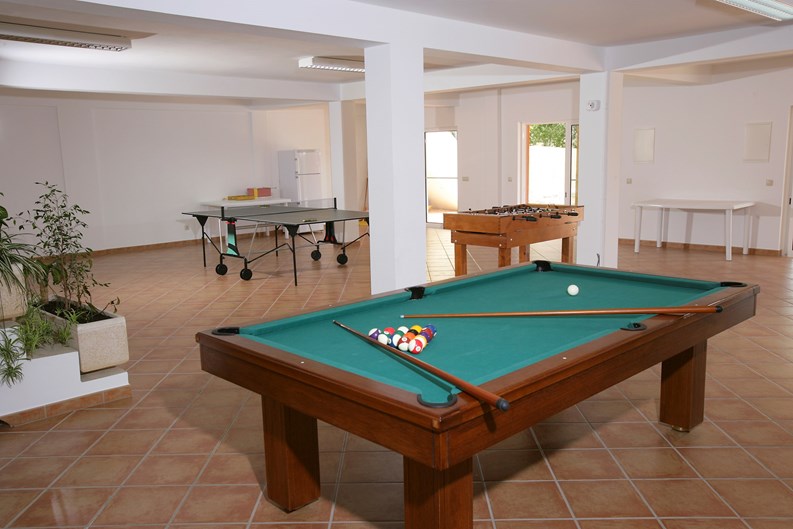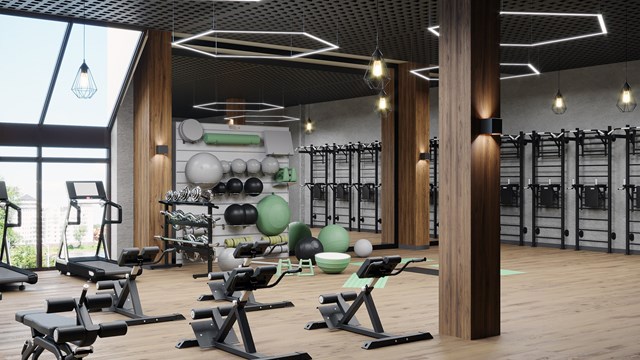In the past, developers would throw a few chairs and tables into a large room and call it a common area or a recreation room and leave it at that. Today, however, there's more to designing, maintaining and upgrading a successful common area than just sweeping the floor and making sure the Nespresso machine is stocked with coffee pods. Over time, fitness centers, business centers, party rooms and movie theaters were added in for residents to enjoy.
Take, for example, 20 East End Avenue in New York City, a luxury condominium development that is currently under construction. Architect Richard J. DeMarco of Manhattan-based firm Montroy Andersen DeMarco says that the building's common areas, such as the library and fitness club, are a definite highlight for residents and buyers.
“The common areas combine both traditional and modern designs, which appeals to younger demographics,” says DeMarco. “The building’s library, and its billiards and game room, showcase rich, dark millwork, elaborate coffered ceilings, and other traditional high-end finishes typical of exclusive private clubs. The fitness center also reflects tastes of a younger demographic, including the prototypical design of commercial New York City gyms, with industrial exposed ceilings and infrastructure, together with the use of stronger, bolder colors.”
Design Elements
According to the pros, common areas in multifamily buildings, particularly in denser urban areas where individual apartments may not exactly be spacious, are often used as an extension of residents' homes. Newly-built condo buildings might include common amenities such as theaters or screening lounges, billiard rooms and wine cellars. “Today owners are looking for social space, so the lounge space now has work tables where technology has been integrated,” says one designer. “Before, the lounge space had been designed solely for watching TV, but now we provide work tables with plug-ins and comfortable chairs.”
Successful common areas include specific design elements that make the room aesthetically-pleasing and functional, not only for current residents but in a way that is attractive to new buyers as well. “A common area is successful if it is warm and welcoming and you feel like you’re home before you even get into your home,” says Gia Milazzo-Smith, founder of Designs by Gia Interior Designs, based in Massachusetts. “They should have warm, inviting colors that are soothing and uncluttered furnishings that can be used by everyone.”
Common Room Usage
One thing that has surprised Greg Howe, a principal of Searl Lamaster Howe Architects in Chicago about today’s common areas is just how heavily they are used. “Some days now they are packed, because more people are working from home and are looking for an escape spot.”
Designers say that a successful common area starts from the outside in. “You have to start from the exterior,” says Wendell Gooch, a principal with Gooch Design Studio LLC in Chicago. “How the building vestibule is presented, the curb appeal of the exterior, the canopy, if it’s well lit, if you have a plant program and walk-off mats—it's all part of a successful common room.”
Next, it’s important to get to know your residents and what they want in their common room. “The industrial loft aesthetic often sought by millennials has been making inroads into common areas, even in luxury buildings that typically cater to an older, more affluent demographic,” says DeMarco. “For example, the Soori High Line luxury condominium in Manhattan reflects the expectations of this property’s target residents, who are affluent international buyers. This demographic group tends to prefer more modern design, with plenty of light and open spaces, which is reflected in the design of Soori’s lobby lounge and gym.”
DeMarco explains that in luxury properties, common areas generally reflect the status aspirations and entertainment needs of residents by offering high-end finishes and impressive views from top-floor and rooftop locations. “These design solutions allow residents to share the dramatic features of their residences when they host social functions,” he says.
If, say, a building has residents that are more families with children, parents would probably enjoy having a common area that is a children’s play area located close or next to the laundry room. In properties where there is a mix of single residents and families, a gym could provide a section for adults, but also a section with windows looking into the children’s playroom.
Designer Robin Wilson, founder and CEO of Robin Wilson Home in New York City, and author of the book Clean Design: Wellness for Your Lifestyle, says that common elements should include comfortable/durable/easily cleaned seating, non-slip flooring and layers of lighting (sconces, overhead and lamps or task lighting). “Lounges, media and play rooms should include televisions, wifi routers, seating for all ages, easily cleaned seating and flooring, storage for items with locks if appropriate for remotes, coffee supplies and toy bins. Lobbies [should feature] a simple layout with seating that can be rearranged, with warm, welcoming lighting and easily-cleaned flooring options.”
Successful design is all about flexibility too. “Put a pool table in the room, but make sure there are flexible seating arrangements so they can make changes depending on what kind of event they are holding,” says Milazzo-Smith.
Fun in, Sound Out
DeMarco says that his firm has also has added acoustical properties to common rooms, so they aren’t as noisy. “We have used cork floors, which mitigate both the echo from conversations as well as the transfer of vibrations to spaces located below the floors,” he says. “New ceiling systems, such as cloud ceilings and spray-on acoustical finishes, are also becoming increasingly popular.”
Good acoustic design is very important as well. The pros agree that it's imperative to select proper finishes, so as to not wind up with an acoustically 'bright' space that creates uncomfortable levels of sound reverberation during social gatherings.
Energy efficiency is another important aspect of new materials and systems. “LED lighting fixtures, which are highly efficient and reduce maintenance costs, are currently very popular,” says DeMarco. “Especially since their initial cost has fallen down significantly in recent years.”
Outdoor common areas, particularly those that offer views from rooftops, continue to be highly valued and desired by residents in urban environments, such as New York, Chicago, or Miami. “These spaces should be thoughtfully designed to accommodate entertainment activities for the building’s residents,” says DeMarco. “They should offer cooking facilities, warming kitchens, wet bars, grills and fireplaces, along with appropriate seating sections, and shaded areas with trellises.
According to many design professionals, water elements have lately become a popular feature on rooftop community spaces as well, with many newer buildings either including pools, Jacuzzis or other water element to cool off residents on the roof deck, or installing them in response to residents' requests.
Common Room Blunders
Unfortunately, not all designers and developers know what it takes to make a common room that will be frequently used by its residents. “Design blunders and errors are typically related to misunderstanding the lifestyles of residents, layouts that impede traffic patterns and desired usage, and ineffective acoustical engineering,” DeMarco says. “One of the most frequent design errors is either a lack of, or insufficient, warm-up kitchens. This makes it hard for residents to properly organize catered events.”
Another cardinal common area sin is lack of light. Dark and dingy does not a popular common room make—particularly in New York City where the views from even a low-rise can be fantastic. “If you have a common room that no one is using,” says one pro, “it’s probably because the windows aren’t being taken advantage of.”
In some buildings, the common areas simply seem to stand out like a sore thumb compared to the rest of the building. “It’s all about design language of the room,” says Gooch. “The designers put the wrong molding on the columns or the wrong paint on the trim. Maintenance and design matter, and respecting the type of building it is where it starts. It reinforces authenticity and shows the residents that you care.”
Upgrade Options
If your building’s common rooms leave a little to be desired, the board should consider working with designers and architects who can provide adequate solutions. “When we get a call by someone appointed to the board, we have a meeting and first discuss the budget, the residents’ needs and the limitations of the space,” says Milazzo-Smith. “Then, once we have a complete presentation with our design ideas, we get it to the board and then wait for their decision.”
Designers approaching a new project or a renovation first perform a diligent analysis of the demographics in the building (who lives there?), usage patterns, efficiencies, inefficiencies, and the desired functions of common areas. “The feedback from the HOA, individual residents, and building management is crucial in the pre-design phase,” says DeMarco.
The design process should also involve creating out-of-the-box solutions. “For example, the current design trends call for airy spaces with plenty of natural light,” says DeMarco. “When approaching a redesign of a common area located in a cellar without windows, a creative designer should still be able to incorporate this trend—maybe by including faux clerestory windows (windows located below ceilings) that imitate natural light.”
Turning to the experts for advice is vital during the design process. “Property managers know a good job when they see it, but don’t know how they get there,” says Gooch. “The higher the quality of people they employ to design the room, the better it is for them. Engineers are going to care for the materials and put together a bid package and ask what the objectives are. The condo boards often have no idea how much things cost, so we put together a reserve study and price out all of the items that should be included. It helps them to say yes, or we need to wait a year and go back and raise the money.”
Howe explains that, overall, creating a successful common room, “It's all about how you create an intimate space in a larger-scale space.”
Lisa Iannucci is a freelance writer and a frequent contributor to The Cooperator.










Leave a Comment